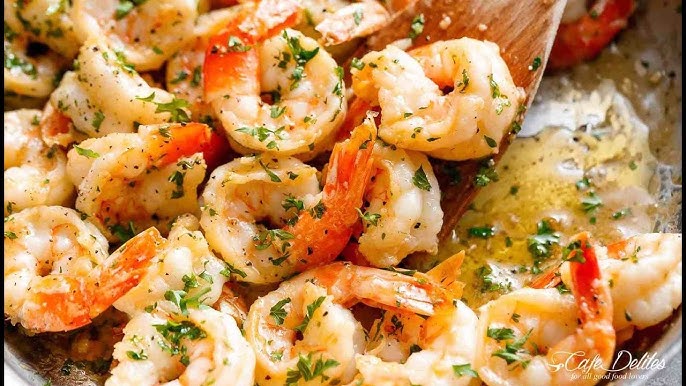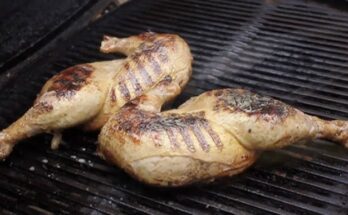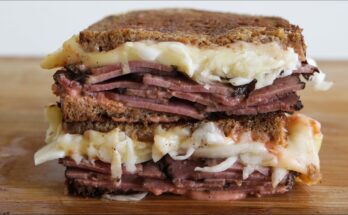Easy Shrimp Scampi Recipe: Shrimp Scampi is one of those dishes that sounds fancy but is surprisingly easy to make at home. It’s the go-to meal when you’re craving something flavorful, fast, and elegant. You’ve probably seen it on restaurant menus, but here’s a secret: you can make it even better in your own kitchen—with half the effort and cost.
At its core, shrimp scampi is a dish that features juicy shrimp sautéed in a garlicky, buttery sauce, often spiked with white wine and fresh lemon juice. It’s typically served over a bed of pasta, making it both hearty and indulgent. The flavors are bright, zesty, and comforting all at once—like sunshine in a bowl.
Why is this recipe so popular? Simple. It hits all the right notes: fast prep, short cook time, and maximum flavor. Whether you’re cooking for a date night, a quick weeknight dinner, or a dinner party, shrimp scampi delivers every time.
Ingredients You’ll Need
Let’s talk about what goes into making the perfect shrimp scampi. The ingredients list is short, but each one packs a punch. Here’s everything you need:
Main Ingredients:
- Shrimp – Use large or jumbo shrimp, peeled and deveined. Fresh or frozen both work, just make sure to thaw completely if frozen.
- Garlic – Lots of it. Freshly minced garlic brings depth and aroma.
- Butter – The foundation of the sauce, gives that rich, velvety texture.
- Olive Oil – Helps balance the butter and prevents burning.
- White Wine – A dry white wine like Sauvignon Blanc adds acidity and complexity.
- Lemon Juice – Brightens up the dish and balances the richness.
- Parsley – For garnish and a touch of fresh flavor.
- Red Pepper Flakes (optional) – For a gentle kick.
Optional Add-Ins:
- Shallots – Adds a subtle sweetness.
- Cherry Tomatoes – Introduces a pop of color and acidity.
- Grated Parmesan – For those who love a cheesy finish.
Ingredient Substitutes:
- No wine? Use chicken broth with a splash of lemon juice.
- No fresh shrimp? Pre-cooked works in a pinch, but add it at the end to avoid overcooking.
- Gluten-free? Swap pasta for zucchini noodles or gluten-free linguine.
The magic of shrimp scampi is in how these simple ingredients come together to make something extraordinary. Keep it classic, or put your twist on it—either way, it’s going to be delicious.
Tools and Equipment Required
Before diving into the cooking process, make sure you have the right tools on hand. You don’t need a fancy setup—just the essentials will do.
Essential Kitchen Tools:
- Large Skillet or Sauté Pan – Preferably non-stick or stainless steel.
- Pot for Pasta – Big enough to boil spaghetti or linguine.
- Tongs or a Spatula – For flipping and tossing shrimp.
- Cutting Board and Sharp Knife – For prepping garlic, parsley, and lemon.
Optional Tools for Convenience:
- Garlic Press – Speeds up the mincing.
- Microplane – Great for zesting lemons or grating Parmesan.
- Colander – To drain pasta quickly and efficiently.
Having everything prepped and within arm’s reach will make your cooking process smoother and faster. A little kitchen organization goes a long way, especially when working with quick-cooking ingredients like shrimp.
Prepping for the Recipe
Preparation is the key to success in any kitchen adventure. When it comes to shrimp scampi, a little prep work ensures your dish comes together seamlessly.
How to Prepare Shrimp:
- Thawing: If using frozen shrimp, let them thaw in a bowl of cold water for about 15-20 minutes.
- Peeling and Deveining: Peel the shell off and use a paring knife to remove the dark vein running along the back.
- Drying: Pat them dry with a paper towel so they sear instead of steam in the pan.
Tips for Freshness and Flavor:
- Use shrimp within a day or two of buying if fresh.
- Keep them chilled until right before cooking.
- Season the shrimp lightly with salt and pepper before cooking to boost flavor.
Pro tip: Fresh parsley and a squeeze of lemon juice at the end lift the whole dish. It’s those small details that take your scampi from “good” to “gourmet.”
Step-by-Step Shrimp Scampi Recipe
Now, let’s get into the heart of the matter: cooking the scampi. This part moves fast, so read through the steps first before firing up the stove.
Step 1: Marinate the Shrimp
- Toss your cleaned shrimp in a bowl with a bit of olive oil, minced garlic, and a dash of red pepper flakes.
- Let it sit for about 10-15 minutes while you prep the other ingredients.
- This gives the shrimp a flavor boost and gets the garlic infused early.
Step 2: Cook the Pasta
- Bring a pot of salted water to a boil.
- Cook spaghetti, linguine, or your pasta of choice until al dente.
- Drain and reserve a cup of pasta water—it’ll help bind the sauce later.
Step 3: Sauté the Garlic and Shrimp
- Heat a large skillet over medium-high heat with butter and olive oil.
- Add garlic and cook for 30 seconds (don’t let it burn).
- Add shrimp in a single layer and cook for about 2-3 minutes per side, or until they turn pink and slightly golden.
Step 4: Add Wine and Lemon Juice
Once your shrimp are beautifully pink and just starting to brown, it’s time to add some zing. Deglaze the pan by pouring in the white wine—this lifts all the delicious brown bits from the bottom of the skillet, packing even more flavor into the dish. Stir in freshly squeezed lemon juice to brighten everything up.
Let it simmer for 2–3 minutes, allowing the alcohol to cook off and the flavors to meld together. At this point, your kitchen is going to smell amazing—but you’re not done yet! You want the sauce to reduce just a bit so it lightly coats the shrimp and forms a glossy base for the pasta.
If you’re not using wine, a good chicken broth with a splash of vinegar or extra lemon juice can mimic that acidity. Don’t skip this step—it’s what gives shrimp scampi its signature tang and depth.
Step 5: Toss with Pasta and Garnish
Now the fun part: putting it all together. Toss your cooked, drained pasta right into the pan with the shrimp and sauce. If the mixture feels a bit dry, add some reserved pasta water, one tablespoon at a time, until you reach a silky consistency.
Sprinkle in chopped fresh parsley and, if you’re feeling indulgent, a touch of grated Parmesan. Give everything a good toss so the pasta gets coated in that garlicky, buttery, lemony goodness.
Before serving, taste for seasoning. You may want a pinch more salt or another squeeze of lemon juice. Plate it up and serve hot, ideally with a crusty slice of garlic bread or a fresh salad.
Cooking Tips and Tricks
Making shrimp scampi isn’t complicated, but there are a few tricks to get it restaurant-quality every time.
Getting the Perfect Sear on Shrimp
- Use a hot pan and dry shrimp. Moisture is the enemy of browning.
- Don’t overcrowd the pan—work in batches if needed.
- Let the shrimp sit undisturbed for a minute before flipping. That’s how you get that lovely caramelized edge.
Avoiding Overcooked Shrimp
- Shrimp cook FAST—usually in 2–3 minutes per side.
- They’re done when they curl into a loose “C” shape and are opaque throughout.
- If they curl tightly into an “O,” they’re overcooked (still tasty, but a little chewy).
Enhancing Flavor Profiles
- Add a splash of pasta water for a silkier sauce.
- Use lemon zest along with juice for added brightness.
- A small pinch of sugar can balance overly tart wine or lemon.
With these little tweaks, you’ll take your shrimp scampi from basic to boss level.
Serving Suggestions
This dish is versatile and elegant, perfect on its own or paired with the right side. Here’s how to round out your meal:
Best Side Dishes
- Garlic Bread: Classic, crunchy, and perfect for soaking up leftover sauce.
- Steamed Veggies: Broccoli, asparagus, or green beans balance out the richness.
- Caesar Salad: Crisp romaine and creamy dressing make a great contrast.
Wine Pairing Ideas
- White Wines: Go for something dry like Sauvignon Blanc, Pinot Grigio, or Chardonnay.
- Rosé: A light, dry rosé works surprisingly well.
- Sparkling Wine: Yes, bubbles! They cut through the richness and feel celebratory.
Whether you’re serving guests or treating yourself, these pairings make shrimp scampi shine even brighter.
Storing and Reheating
Shrimp scampi is best served fresh, but that doesn’t mean you can’t enjoy leftovers.
Refrigeration Tips
- Store leftovers in an airtight container in the fridge for up to 3 days.
- Keep the shrimp and pasta together, so the sauce doesn’t dry out.
Reheating Without Drying Out
- Stovetop Method: Add a splash of water or broth to a skillet and warm over medium-low heat. Stir gently.
- Microwave Method: Use a microwave-safe dish, add a tablespoon of water, cover loosely, and reheat in 30-second intervals.
Avoid overcooking when reheating—the shrimp is already cooked, and you just want to warm it through. A little attention goes a long way here.
Variations of Shrimp Scampi
Feeling creative? Shrimp scampi is a great base for customization. Here are some fun ways to switch it up:
Low-Carb/Keto Version
- Ditch the pasta and go for zoodles (zucchini noodles) or spaghetti squash.
- Keep the sauce the same—it’s naturally low-carb and full of flavor.
Spicy Scampi
- Add extra red pepper flakes or a diced chili pepper to the garlic.
- A dash of hot sauce or cayenne powder will also bring the heat.
Creamy Scampi
- Stir in a splash of heavy cream or half-and-half right before adding the pasta.
- Top with Parmesan for a luxurious finish.
Each version brings something new to the table—try them all and find your favorite twist!
Nutritional Information
Let’s be honest—we’re not always counting calories when diving into a buttery bowl of shrimp scampi, but it’s still nice to know what’s on your plate. The beauty of this dish is that it’s relatively light compared to other pasta recipes, especially if you skip the cream or cheese-heavy versions.
Calorie Breakdown (per serving):
- Shrimp (6–8 large pieces): 100–120 calories
- Pasta (1 cup cooked): 200–220 calories
- Butter and Oil: 150–200 calories
- White Wine and Lemon Juice: 30–50 calories
- Garlic, Parsley, Spices: Negligible
Total Estimate: Around 500–600 calories per serving
Macronutrient Content:
- Protein: 25–30g (thanks to shrimp)
- Carbohydrates: 35–45g (from pasta)
- Fats: 20–25g (mostly from butter and olive oil)
If you’re going for a low-carb or keto-friendly option, switching pasta for zoodles can drop the carb count below 10g while keeping the fat and protein high.
The dish is also rich in omega-3 fatty acids, selenium, and vitamin B12 from the shrimp—so you’re not just satisfying your taste buds but giving your body a little boost, too.
Common Mistakes to Avoid
Shrimp scampi is a forgiving dish, but a few missteps can impact the final result. Here’s what to watch out for:
Overcooking the Shrimp
This is the number one pitfall. Shrimp cook fast and go from perfect to rubbery in seconds. Watch closely and remove them from heat the moment they turn pink and opaque.
Using Too Much Lemon
A little acidity brightens the dish, but too much can overwhelm it. Stick to the juice of one lemon for balance. Want more tang? Add zest instead of extra juice.
Not Deglazing the Pan Properly
Don’t skip the wine or broth step—it lifts all those flavorful bits off the pan and forms the base of your sauce. Let it simmer and reduce slightly for best results.
Skipping the Pasta Water
A little reserved pasta water helps emulsify the sauce, giving it a glossy, restaurant-worthy finish. It’s a simple step with a big payoff.
Avoid these common issues, and your scampi will be perfect every single time.
Why This Shrimp Scampi Recipe Works
This recipe isn’t just easy—it’s foolproof and packed with flavor. Let’s break down why it hits all the right notes:
Flavor Balance
- Garlic, butter, and olive oil form a rich base.
- Lemon and wine add brightness and acidity.
- A touch of heat and parsley bring depth and color.
It’s a dish where every ingredient plays a role and nothing overpowers.
Quick Cooking Time
This is one of the fastest gourmet dishes you can make. Prep and cooking combined take under 30 minutes, making it ideal for busy weeknights or impromptu dinner guests.
Versatility
You can customize this recipe to fit almost any diet or preference:
- Low-carb? Use veggie noodles.
- Dairy-free? Skip the butter.
- No wine? Use broth.
It’s endlessly adaptable and always delicious. That’s the kind of recipe you keep coming back to.
FAQs about Easy Shrimp Scampi Recipe
1. What is shrimp scampi made of?
Shrimp scampi is typically made with shrimp, garlic, butter, olive oil, white wine or chicken broth, lemon juice, and parsley—often served over pasta.
2. Can I use frozen shrimp for shrimp scampi?
Yes! Just make sure to thaw and pat them dry before cooking to avoid excess water in the pan.
3. What can I substitute for white wine in shrimp scampi?
Chicken broth or seafood stock is a great non-alcoholic substitute that still adds rich flavor.
4. How do I keep shrimp from overcooking?
Shrimp cook very quickly—usually in 2–3 minutes per side. As soon as they turn pink and opaque, remove them from heat.
5. Can I make shrimp scampi without pasta?
Absolutely! Try serving it with rice, mashed potatoes, or crusty bread to soak up the sauce.
6. Is shrimp scampi spicy?
Traditionally, it’s not. But you can add red pepper flakes if you like a bit of heat.
7. How long does shrimp scampi last in the fridge?
It stays fresh for up to 3 days in an airtight container. Reheat gently to avoid overcooking the shrimp.
8. Can I use cooked shrimp instead of raw?
Yes, but add them at the very end just to warm through. Overcooking pre-cooked shrimp can make them rubbery.
9. What type of pasta works best with shrimp scampi?
Linguine, spaghetti, or angel hair are classic choices that pair perfectly with the light, garlicky sauce.
10. Can I make shrimp scampi dairy-free?
Yes! Substitute the butter with a plant-based alternative or use extra olive oil for a dairy-free version.
Final Thoughts
Shrimp scampi is a dream dish: elegant, easy, and full of flavor. It’s one of those rare meals that feels like a treat but doesn’t demand hours in the kitchen. Whether you’re cooking for one, feeding the family, or impressing dinner guests, it never fails to deliver.
Simple ingredients, fast prep, and endless customization—that’s what makes this shrimp scampi recipe a keeper. Once you try it, you’ll see just how effortless gourmet cooking can be. So grab that skillet, some shrimp, and let’s get cooking.



